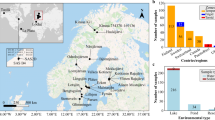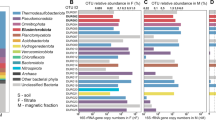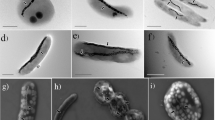Abstract
Magnetotactic bacteria (MTB) of the genus ‘Candidatus Magnetobacterium’ in phylum Nitrospirae are of great interest because of the formation of hundreds of bullet-shaped magnetite magnetosomes in multiple bundles of chains per cell. These bacteria are worldwide distributed in aquatic environments and have important roles in the biogeochemical cycles of iron and sulfur. However, except for a few short genomic fragments, no genome data are available for this ecologically important genus, and little is known about their metabolic capacity owing to the lack of pure cultures. Here we report the first draft genome sequence of 3.42 Mb from an uncultivated strain tentatively named ‘Ca. Magnetobacterium casensis’ isolated from Lake Miyun, China. The genome sequence indicates an autotrophic lifestyle using the Wood–Ljungdahl pathway for CO2 fixation, which has not been described in any previously known MTB or Nitrospirae organisms. Pathways involved in the denitrification, sulfur oxidation and sulfate reduction have been predicted, indicating its considerable capacity for adaptation to variable geochemical conditions and roles in local biogeochemical cycles. Moreover, we have identified a complete magnetosome gene island containing mam, mad and a set of novel genes (named as man genes) putatively responsible for the formation of bullet-shaped magnetite magnetosomes and the arrangement of multiple magnetosome chains. This first comprehensive genomic analysis sheds light on the physiology, ecology and biomineralization of the poorly understood ‘Ca. Magnetobacterium’ genus.
Similar content being viewed by others
Log in or create a free account to read this content
Gain free access to this article, as well as selected content from this journal and more on nature.com
or
Accession codes
References
Amann R, Krumholz L, Stahl DA . (1990). Fluorescent-oligonucleotide probing of whole cells for determinative, phylogenetic, and environmental studies in microbiology. J Bacteriol 172: 762–770.
Arnold K, Bordoli L, Kopp J, Schwede T . (2006). The SWISS-MODEL workspace: a web-based environment for protein structure homology modelling. Bioinformatics 22: 195–201.
Aziz RK, Bartels D, Best AA, DeJongh M, Disz T, Edwards RA et al. (2008). The RAST server: rapid annotations using subsystems technology. BMC Genomics 9: 75.
Barak I, Wilkinson AJ . (2007). Division site recognition in Escherichia coli and Bacillus subtilis. FEMS Microbiol Rev 31: 311–326.
Bazylinski D, Lefèvre C, Schüler D . (2013). Magnetotactic bacteria. In: Rosenberg E, DeLong E, Lory S, Stackebrandt E, Thompson F (eds) The Prokaryotes. Springer: Berlin Heidelberg, pp 453–494.
Bazylinski DA, Dean AJ, Williams TJ, Long LK, Middleton SL, Dubbels BL . (2004). Chemolithoautotrophy in the marine, magnetotactic bacterial strains MV-1 and MV-2. Arch Microbiol 182: 373–387.
Bazylinski DA, Frankel RB . (2004). Magnetosome formation in prokaryotes. Nat Rev Microbiol 2: 217–230.
Benkert P, Schwede T, Tosatto SCE. (2009). QMEANclust: estimation of protein model quality by combining a composite scoring function with structural density information. BMC Struct Biol 9: 35.
Berg IA . (2011). Ecological aspects of the distribution of different autotrophic CO2 fixation pathways. Appl Environ Microbiol 77: 1925–1936.
Brown MT, Delalez NJ, Armitage JP . (2011). Protein dynamics and mechanisms controlling the rotational behaviour of the bacterial flagellar motor. Curr Opin Microbiol 14: 734–740.
Brune A, Frenzel P, Cypionka H . (2000). Life at the oxic–anoxic interface: microbial activities and adaptations. FEMS Microbiol Rev 24: 691–710.
Castresana J . (2000). Selection of conserved blocks from multiple alignments for their use in phylogenetic analysis. Mol Biol Evol 17: 540–552.
Chevreux B, Wetter T, Suhai S . (1999). Genome sequence assembly using trace signals and additional sequence information. Comput Sci Biol GCB99: 45–56.
Cypionka H . (1994). Novel metabolic capacities of sulfate-reducing bacteria, and their activities in microbial mats. In: Stal L, Caumette P (eds) Microbial Mats. Springer: Berlin Heidelberg, pp 367–376.
Dahl C, Engels S, Pott-Sperling AS, Schulte A, Sander J, Lübbe Y et al. (2005). Novel genes of the dsr gene cluster and evidence for close interaction of Dsr proteins during sulfur oxidation in the phototrophic sulfur bacterium Allochromatium vinosum. J Bacteriol 187: 1392–1404.
Dannenberg S, Kroder M, Dilling W, Cypionka H . (1992). Oxidation of H2, organic compounds and inorganic sulfur compounds coupled to reduction of O2 or nitrate by sulfate-reducing bacteria. Arch Microbiol 158: 93–99.
Dilling W, Cypionka H . (1990). Aerobic respiration in sulfate-reducing bacteria. FEMS Microbiol Lett 71: 123–127.
Draper O, Byrne ME, Li Z, Keyhani S, Barrozo JC, Jensen G et al. (2011). MamK, a bacterial actin, forms dynamic filaments in vivo that are regulated by the acidic proteins MamJ and LimJ. Mol Microbiol 82: 342–354.
Edgar RC . (2004). MUSCLE: multiple sequence alignment with high accuracy and high throughput. Nucleic Acids Res 32: 1792–1797.
Forbes JR, Gros P . (2001). Divalent-metal transport by NRAMP proteins at the interface of host-pathogen interactions. Trends Microbiol 9: 397–403.
Frankel RB, Bazylinski DA, Johnson MS, Taylor BL . (1997). Magneto-aerotaxis in marine coccoid bacteria. Biophys J 73: 994–1000.
Garrity G, Holt J . (2001). Phylum BVIII. Nitrospirae phy. nov. In: Boone D, Castenholz R (eds) Bergey’s Manual of Systematic Bacteriology. Springer: New York, pp 451–464.
Giltner CL, Nguyen Y, Burrows LL . (2012). Type IV pilin proteins: versatile molecular modules. Microbiol Mol Biol Rev 76: 740–772.
Goltsman DSA, Denef VJ, Singer SW, VerBerkmoes NC, Lefsrud M, Mueller RS et al. (2009). Community genomic and proteomic analyses of chemoautotrophic iron-oxidizing ‘Leptospirillum rubarum’ (Group II) and ‘Leptospirillum ferrodiazotrophum’ (Group III) bacteria in acid mine drainage biofilms. Appl Environ Microbiol 75: 4599–4615.
Gouet P, Courcelle E, Stuart DI, Metoz F . (1999). ESPript: analysis of multiple sequence alignments in PostScript. Bioinformatics 15: 305–308.
Guindon S, Dufayard JF, Lefort V, Anisimova M, Hordijk W, Gascuel O . (2010). New algorithms and methods to estimate maximum-likelihood phylogenies: assessing the performance of PhyML 3.0. Syst Biol 59: 307–321.
Hattori S, Galushko AS, Kamagata Y, Schink B . (2005). Operation of the CO dehydrogenase/acetyl coenzyme A pathway in both acetate oxidation and acetate formation by the syntrophically acetate-oxidizing bacterium Thermacetogenium phaeum. J Bacteriol 187: 3471–3476.
Henry EA, Devereux R, Maki JS, Gilmour CC, Woese CR, Mandelco L et al. (1994). Characterization of a new thermophilic sulfate-reducing bacterium. Arch Microbiol 161: 62–69.
Holkenbrink C, Ocón Barbas S, Mellerup A, Otaki H, Frigaard N-U . (2011). Sulfur globule oxidation in green sulfur bacteria is dependent on the dissimilatory sulfite reductase system. Microbiology 157: 1229–1239.
Hopkinson BM, Barbeau KA . (2012). Iron transporters in marine prokaryotic genomes and metagenomes. Environ Microbiol 14: 114–128.
Hügler M, Sievert SM . (2011). Beyond the Calvin cycle: autotrophic carbon fixation in the ocean. Annu Rev Mar Sci 3: 261–289.
Jensen RB, Shapiro L . (2003). Cell-cycle-regulated expression and subcellular localization of the Caulobacter crescentus SMC chromosome structural protein. J Bacteriol 185: 3068–3075.
Ji B, Zhang S-D, Arnoux P, Rouy Z, Alberto F, Philippe N et al. (2014). Comparative genomic analysis provides insights into the evolution and niche adaptation of marine Magnetospira sp. QH-2 strain. Environ Microbiol 16: 525–544.
Jogler C, Lin W, Meyerdierks A, Kube M, Katzmann E, Flies C et al. (2009). Towards cloning the magnetotactic metagenome: identification of magnetosome island gene clusters in uncultivated magnetotactic bacteria from different aquatic sediments. Appl Environ Microbiol 75: 3972–3979.
Jogler C, Niebler M, Lin W, Kube M, Wanner G, Kolinko S et al. (2010). Cultivation-independent characterization of ‘Candidatus Magnetobacterium bavaricum’ via ultrastructural, geochemical, ecological and metagenomic methods. Environ Microbiol 12: 2466–2478.
Jogler C, Wanner G, Kolinko S, Niebler M, Amann R, Petersen N et al. (2011). Conservation of proteobacterial magnetosome genes and structures in an uncultivated member of the deep-branching Nitrospira phylum. Proc Natl Acad Sci USA 108: 1134–1139.
Katzmann E, Scheffel A, Gruska M, Plitzko JM, Schüler D . (2010). Loss of the actin-like protein MamK has pleiotropic effects on magnetosome formation and chain assembly in Magnetospirillum gryphiswaldense. Mol Microbiol 77: 208–224.
Kawasaki S, Arai H, Kodama T, Igarashi Y . (1997). Gene cluster for dissimilatory nitrite reductase (nir) from Pseudomonas aeruginosa: sequencing and identification of a locus for heme d1 biosynthesis. J Bacteriol 179: 235–242.
Kolinko S, Jogler C, Katzmann E, Wanner G, Peplies J, Schüler D . (2012). Single-cell analysis reveals a novel uncultivated magnetotactic bacterium within the candidate division OP3. Environ Microbiol 14: 1709–1721.
Komeili A, Li Z, Newman DK, Jensen GJ . (2006). Magnetosomes are cell membrane invaginations organized by the actin-like protein MamK. Science 311: 242–245.
Komeili A . (2012). Molecular mechanisms of compartmentalization and biomineralization in magnetotactic bacteria. FEMS Microbiol Rev 36: 232–255.
Kunisawa T . (2010). Evaluation of the phylogenetic position of the sulfate-reducing bacterium Thermodesulfovibrio yellowstonii (phylum Nitrospirae) by means of gene order data from completely sequenced genomes. Int J Syst Evol Microbiol 60: 1090–1102.
Lefèvre CT, Bazylinski DA . (2013). Ecology, diversity, and evolution of magnetotactic bacteria. Microbiol Mol Biol Rev 77: 497–526.
Lefèvre CT, Trubitsyn D, Abreu F, Kolinko S, de Almeida LGP, de Vasconcelos ATR et al. (2013a). Monophyletic origin of magnetotaxis and the first magnetosomes. Environ Microbiol 15: 2267–2274.
Lefèvre CT, Trubitsyn D, Abreu F, Kolinko S, Jogler C, de Almeida LGP et al. (2013b). Comparative genomic analysis of magnetotactic bacteria from the Deltaproteobacteria provides new insights into magnetite and greigite magnetosome genes required for magnetotaxis. Environ Microbiol 15: 2712–2735.
Lefèvre CT, Wu L-F . (2013). Evolution of the bacterial organelle responsible for magnetotaxis. Trends Microbiol 21: 534–543.
Levican G, Ugalde J, Ehrenfeld N, Maass A, Parada P . (2008). Comparative genomic analysis of carbon and nitrogen assimilation mechanisms in three indigenous bioleaching bacteria: predictions and validations. BMC Genomics 9: 581.
Li J, Pan Y, Liu Q, Yu-Zhang K, Menguy N, Che R et al. (2010). Biomineralization, crystallography and magnetic properties of bullet-shaped magnetite magnetosomes in giant rod magnetotactic bacteria. Earth Planet Sci Lett 293: 368–376.
Lin W, Li J, Schüler D, Jogler C, Pan Y . (2009). Diversity analysis of magnetotactic bacteria in Lake Miyun, northern China, by restriction fragment length polymorphism. Syst Appl Microbiol 32: 342–350.
Lin W, Pan Y . (2010). Temporal variation of magnetotactic bacterial communities in two freshwater sediment microcosms. FEMS Microbiol Lett 302: 85–92.
Lin W, Jogler C, Schüler D, Pan Y . (2011). Metagenomic analysis reveals unexpected subgenomic diversity of magnetotactic bacteria within the phylum Nitrospirae. Appl Environ Microbiol 77: 323–326.
Lin W, Li J, Pan Y . (2012). Newly isolated but uncultivated magnetotactic bacterium of the phylum Nitrospirae from Beijing, China. Appl Environ Microbiol 78: 668–675.
Lin W, Bazylinski DA, Xiao T, Wu L-F, Pan Y . (2014). Life with compass: diversity and biogeography of magnetotactic bacteria. Environ Microbiol 16 doi:10.1111/1462-2920.12313.
Lucker S, Wagner M, Maixner F, Pelletier E, Koch H, Vacherie B et al. (2010). A Nitrospira metagenome illuminates the physiology and evolution of globally important nitrite-oxidizing bacteria. Proc Natl Acad Sci USA 107: 13479–13484.
Markert S, Arndt C, Felbeck H, Becher D, Sievert SM, Hügler M et al. (2007). Physiological proteomics of the uncultured endosymbiont of Riftia pachyptila. Science 315: 247–250.
Matsunaga T, Okamura Y, Fukuda Y, Wahyudi AT, Murase Y, Takeyama H . (2005). Complete genome sequence of the facultative anaerobic magnetotactic bacterium Magnetospirillum sp. strain AMB-1. DNA Res 12: 157–166.
Matsunaga T, Suzuki T, Tanaka M, Arakaki A . (2007). Molecular analysis of magnetotactic bacteria and development of functional bacterial magnetic particles for nano-biotechnology. Trends Biotechnol 25: 182–188.
Matsunaga T, Nemoto M, Arakaki A, Tanaka M . (2009). Proteomic analysis of irregular, bullet-shaped magnetosomes in the sulphate-reducing magnetotactic bacterium Desulfovibrio magneticus RS-1. Proteomics 9: 3341–3352.
Moriya Y, Itoh M, Okuda S, Yoshizawa AC, Kanehisa M . (2007). KAAS: an automatic genome annotation and pathway reconstruction server. Nucl Acids Res 35: W182–W185.
Murat D, Quinlan A, Vali H, Komeili A . (2010). Comprehensive genetic dissection of the magnetosome gene island reveals the step-wise assembly of a prokaryotic organelle. Proc Natl Acad Sci USA 107: 5593–5598.
Mussmann M, Hu FZ, Richter M, de Beer D, Preisler A, Jorgensen BB et al. (2007). Insights into the genome of large sulfur bacteria revealed by analysis of single filaments. PLoS Biol 5: 1923–1937.
Nakazawa H, Arakaki A, Narita-Yamada S, Yashiro I, Jinno K, Aoki N et al. (2009). Whole genome sequence of Desulfovibrio magneticus strain RS-1 revealed common gene clusters in magnetotactic bacteria. Genome Res 19: 1801–1808.
Overbeek R, Olson R, Pusch GD, Olsen GJ, Davis JJ, Disz T et al. (2014). The SEED and the Rapid Annotation of microbial genomes using Subsystems Technology (RAST). Nucleic Acids Res 42: D206–D214.
Ozyamak E, Kollman J, Agard DA, Komeili A . (2013). The bacterial actin MamK: in vitro assembly behavior and filament architecture. J Biol Chem 288: 4265–4277.
Pan Y, Lin W, Li J, Wu W, Tian L, Deng C et al. (2009). Reduced efficiency of magnetotaxis in magnetotactic coccoid bacteria in higher than geomagnetic fields. Biophys J 97: 986–991.
Peretó JG, Velasco AM, Becerra A, Lazcano A . (1999). Comparative biochemistry of CO2 fixation and the evolution of autotrophy. Int Microbiol 2: 3–10.
Pettersen EF, Goddard TD, Huang CC, Couch GS, Greenblatt DM, Meng EC et al. (2004). UCSF Chimera—A visualization system for exploratory research and analysis. J Comput Chem 25: 1605–1612.
Pires RH, Lourenço AI, Morais F, Teixeira M, Xavier AV, Saraiva LgM et al. (2003). A novel membrane-bound respiratory complex from Desulfovibrio desulfuricans ATCC 27774. Biochim Biophys Acta 1605: 67–82.
Pott AS, Dahl C . (1998). Sirohaem sulfite reductase and other proteins encoded by genes at the dsr locus of Chromatium vinosum are involved in the oxidation of intracellular sulfur. Microbiology 144: 1881–1894.
Reinartz M, Tschäpe J, Brüser T, Trüper HG, Dahl C . (1998). Sulfide oxidation in the phototrophic sulfur bacterium Chromatium vinosum. Arch Microbiol 170: 59–68.
Richter M, Kube M, Bazylinski DA, Lombardot T, Glockner FO, Reinhardt R et al. (2007). Comparative genome analysis of four magnetotactic bacteria reveals a complex set of group-specific genes implicated in magnetosome biomineralization and function. J Bacteriol 189: 4899–4910.
Schauder R, Preuß A, Jetten M, Fuchs G . (1988). Oxidative and reductive acetyl CoA/carbon monoxide dehydrogenase pathway in Desulfobacterium autotrophicum. 2. Demonstration of the enzymes of the pathway and comparison of CO dehydrogenase. Arch Microbiol 151: 84–89.
Scheffel A, Gruska M, Faivre D, Linaroudis A, Plitzko JM, Schüler D . (2006). An acidic protein aligns magnetosomes along a filamentous structure in magnetotactic bacteria. Nature 440: 110–114.
Scheffel A, Schüler D . (2007). The acidic repetitive domain of the Magnetospirillum gryphiswaldense MamJ protein displays hypervariability but is not required for magnetosome chain assembly. J Bacteriol 189: 6437–6446.
Schübbe S, Williams TJ, Xie G, Kiss HE, Brettin TS, Martinez D et al. (2009). Complete genome sequence of the chemolithoautotrophic marine magnetotactic coccus strain MC-1. Appl Environ Microbiol 75: 4835–4852.
Schüler D . (2008). Genetics and cell biology of magnetosome formation in magnetotactic bacteria. FEMS Microbiol Rev 32: 654–672.
Serata M, Iino T, Yasuda E, Sako T . (2012). Roles of thioredoxin and thioredoxin reductase in the resistance to oxidative stress in Lactobacillus casei. Microbiology 158: 953–962.
Simon J . (2002). Enzymology and bioenergetics of respiratory nitrite ammonification. FEMS Microbiol Rev 26: 285–309.
Spring S, Amann R, Ludwig W, Schleifer KH, van Gemerden H, Petersen N . (1993). Dominating role of an unusual magnetotactic bacterium in the microaerobic zone of a freshwater sediment. Appl Environ Microbiol 59: 2397–2403.
Spring S, Bazylinski DA . (2006). Magnetotactic bacteria. In: Dworkin M (ed) The prokaryotes: an evolving electronic resource for the microbiological community. Springer Verlag: New York, USA, pp 842–862.
Stragier P . (2001). A gene odyssey: exploring the genomes of endospore-forming bacteria. In: Sonenshein L, Losick R, Hoch JA (eds) Bacillus subtilis and its relatives: from genes to cells. American Society for Microbiology: Washington, USA, pp 519–525.
Teske A, Alm E, Regan JM, Toze S, Rittmann BE, Stahl DA . (1994). Evolutionary relationships among ammonia- and nitrite-oxidizing bacteria. J Bacteriol 176: 6623–6630.
Thompson JD, Higgins DG, Gibson TJ . (1994). CLUSTAL W: improving the sensitivity of progressive multiple sequence alignment through sequence weighting, positions-specific gap penalties and weight matrix choice. Nucleic Acids Res 22: 4673–4680.
Vali H, Forster O, Amarantidis G, Petersen N . (1987). Magnetotactic bacteria and their magnetofossils in sediments. Earth Planet Sci Lett 86: 389–400.
Wang X, Wang Q, Zhang W, Wang Y, Li L, Wen T et al. (2014). Complete genome sequence of Magnetospirillum gryphiswaldense MSR-1. Genome Announc 2: e00171–00114.
Williams TJ, Zhang CL, Scott JH, Bazylinski DA . (2006). Evidence for autotrophy via the reverse tricarboxylic acid cycle in the marine magnetotactic coccus strain MC-1. Appl Environ Microbiol 72: 1322–1329.
Wu M, Scott AJ . (2012). Phylogenomic analysis of bacterial and archaeal sequences with AMPHORA2. Bioinformatics 28: 1033–1034.
Yang W, Li RG, Peng T, Zhang Y, Jiang W, Li Y et al. (2010). mamO and mamE genes are essential for magnetosome crystal biomineralization in Magnetospirillum gryphiswaldense MSR-1. Res Microbiol 161: 701–705.
Zhou J, He Q, Hemme CL, Mukhopadhyay A, Hillesland K, Zhou A et al. (2011). How sulphate-reducing microorganisms cope with stress: lessons from systems biology. Nat Rev Micro 9: 452–466.
Acknowledgements
This work was funded by the CAS/SAFEA International Partnership Program for Creative Research Teams (KZCX2-YW-T10), and the NSFC grants 41104041, 41330104 and 31300065.
Author information
Authors and Affiliations
Corresponding author
Ethics declarations
Competing interests
The authors declare no conflict of interest.
Additional information
Supplementary Information accompanies this paper on The ISME Journal website
Supplementary information
Rights and permissions
About this article
Cite this article
Lin, W., Deng, A., Wang, Z. et al. Genomic insights into the uncultured genus ‘Candidatus Magnetobacterium’ in the phylum Nitrospirae. ISME J 8, 2463–2477 (2014). https://doi.org/10.1038/ismej.2014.94
Received:
Revised:
Accepted:
Published:
Issue date:
DOI: https://doi.org/10.1038/ismej.2014.94
This article is cited by
-
Soil Bacterial Communities Across Seven Rhizoma Peanut Cultivars (Arachis glabrata Benth.) Respond to Seasonal Variation
Microbial Ecology (2023)
-
Genome-resolved evidence for functionally redundant communities and novel nitrogen fixers in the deyin-1 hydrothermal field, Mid-Atlantic Ridge
Microbiome (2022)
-
Magnetotactic bacteria and magnetofossils: ecology, evolution and environmental implications
npj Biofilms and Microbiomes (2022)
-
Raman spectroscopic peculiarities of Icelandic poorly crystalline minerals and their implications for Mars exploration
Scientific Reports (2022)
-
Magnetotactic bacteria: concepts, conundrums, and insights from a novel in situ approach using digital holographic microscopy (DHM)
Journal of Comparative Physiology A (2022)



